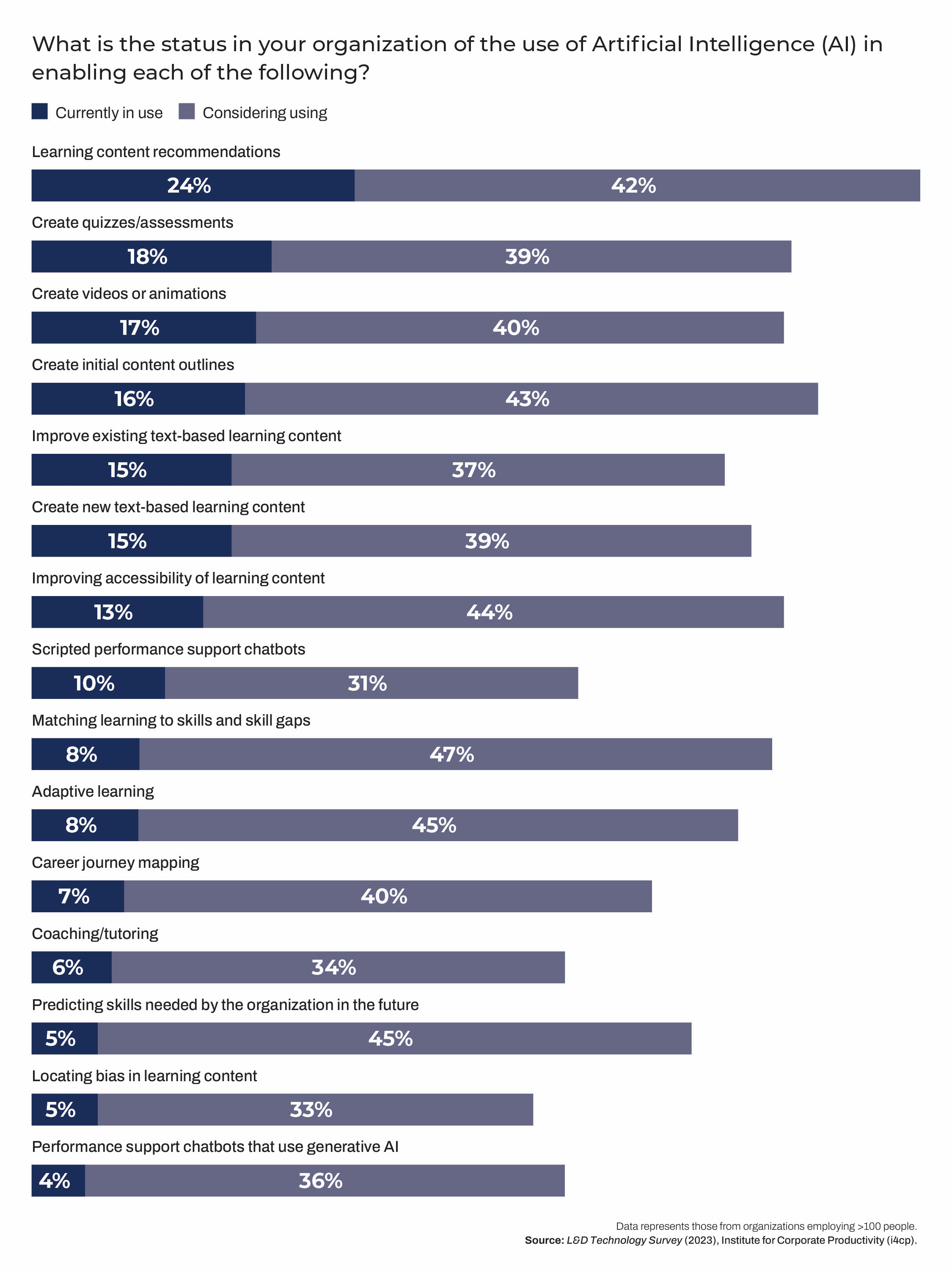
In August 2023, the Institute for Corporate Productivity (i4cp) partnered with Training magazine to conduct a survey of the learning and development technology landscape. More than 500 global learning and development (L&D) leaders and technology specialists participated, providing a robust set of findings.
Overall, results show L&D technology to be at least somewhat effective in supporting a wide range of talent outcomes, with high-performance organizations far more frequently citing key outcomes such as:
- Instilling/reinforcing a strong learning culture
- Enhancing the employee experience
- Producing individual behavior change
Good news came as higher percentages of survey participants say they anticipate L&D technology budget increases (24 percent) in the next fiscal year than decreases (17 percent). This was significantly greater for high-performance organizations (39 percent increase vs. 4 percent decrease). For the research, high-performance firms are those reporting high levels of revenue growth, profitability, market share, and customer satisfaction over a five-year timeframe.
The survey data suggests that the L&D technology ecosystem is as expansive as ever: Next 12 months’ spending priorities range across 17 categories, with learning management systems (LMSs) cited most often by respondents (43 percent), followed by digital learning content providers/libraries (37 percent). Projected niche-area spending includes virtual reality/augmented reality (14 percent), adaptive learning (14 percent), and badging/micro-credentialing (13 percent).
L&D Is Leading the Way with Generative AI in HR
Nestled between most and least common areas of L&D tech spend is the one experiencing the fastest growth—generative artificial intelligence (AI). More than 1 in 5 (21 percent) survey participants said this type of AI (which responds to input and variously produces text, images, video, audio, etc.) is a priority for the next 12 months—a massive leap from a likely near-zero percentage a little more than year ago since generative AI wasn’t publicly introduced until ChatGPT’s debut in November 2022.
Interestingly, a correlation with performance is already manifesting. More than twice as many participants from market-leading organizations say they are prioritizing spending on generative AI for L&D uses over the next 12 months. Only a few other L&D technology categories saw similar performance correlations in the survey:
- Performance support tools and content
- Collaborative learning platforms
- Virtual reality/augmented reality
Other i4cp research, detailed in the report, Is HR Already Behind in the AI Revolution?, surveyed more than 1,500 Human Resources leaders and found that the learning and development function is leading the way in applying AI, particularly generative AI, to work and talent processes. While only a minority (22 percent) of organizations are experimenting with or using generative AI in HR, those doing so are already realizing benefits. Among early AI innovators, 58 percent are applying generative AI in L&D, 57 percent in people analytics, and 54 percent for talent acquisition use cases.
How are L&D professionals using AI? While it remains early days for all use cases, the L&D technology research findings show promise (see Figure 1).

The most common AI use case in L&D is neither particularly new nor novel: learning content recommendations. Most everyone is accustomed to receiving AI-driven recommendations for purchases at Amazon and other e-commerce sites, and AI-driven recommendations on what to watch next from Netflix and other streaming services. Similarly, and for years, many LMS and LXP platforms have provided employees with ever-improving learning content recommendations that leverage algorithms that consider each learner’s job role, past learning experience, future career journey, etc.
What is new is the use of generative AI tools to help create, improve, or draft a wide range of learning-related content, including quizzes and assessments, videos and animations, initial content outlines, and more. AI tools also can help improve the accessibility of learning content by generating draft alt-tags for images or auditing content for potential accessibility and bias issues.
Three of the AI use cases in i4cp’s L&D tech study were deemed next practices—those highly correlated with market performance, but that few organizations are implementing yet:
- Matching learning to skills and skill gaps (8 percent currently in use)
- Adaptive learning (8 percent)
- Career journey mapping (7 percent)
None of the 15 L&D use cases asked about in the survey was in use by more than 25 percent of respondents. However, 50 percent or more of those polled confirmed current or planned use of most of the cases. This is exciting because if these considerations become reality in the next 12 months, this time next year will have seen the most dramatic shift in technology-enabled learning support since the popularization of the Internet and the personal computer—and perhaps eclipsing even those critical innovations.
What to Do Next? Deconstruction and Upskilling
The benefits of using AI—particularly generative AI—are many and can include a mix of cost savings, productivity increases, quality improvements. Even more exciting is the potential to reduce employee burnout and the possibility of shifting human energy and focus away from mundane tasks to more strategic endeavors. L&D leaders and their teams are just beginning to explore the promise of AI, but now is the time to determine which of the many potential use cases are the low-hanging fruit, and which are likely to bring the greatest returns over the long run.
The AI research by i4cp uncovered several practices that organizations proactively using AI are pursuing more often than others. L&D professionals can help take the lead on two of those practices:
- Deconstructing the job roles and tasks that will be most impacted by generative AI
- Developing workers to effectively leverage generative AI
An example within the context of L&D roles can be found in i4cp’s article “How Generative AI Will Forever Change the Role of Instructional Designers.” Download the piece for insights on the specific role of instructional designers and how their work is quickly changing. The article also offers a template for deconstructing a broad range of other roles in anticipation of AI’s impact, and that of generative AI in particular.




